3 交流 / Alternating current (AC)
3.1 正弦交流 / Sinusoidal alternating current
$$
u(t) = u_m \sin (\omega t + \theta)
U = \sqrt{\frac{1}{T} \int_{0}^{T} u^2 } = \frac{u_m}{\sqrt{2} }
$$
其中,$T = \frac{2\pi}{\omega}$。

相量(phasor)形式:$\dot{U} = U \angle \theta$
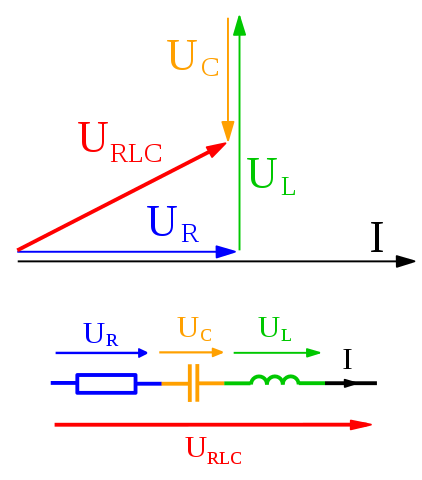
上述电路有:
$$
R\ i + L \frac{\mathrm{d} i}{\mathrm{d} t} + \frac{1}{C} \int i\ \mathrm{d} t = U_{\mathrm{RLC}}
$$
3.2 阻抗和导纳 / Impedance and admittance
3.2.1 阻抗 / Impedance
电路中电阻、电感、电容对交流电的阻碍作用的统称。单位:Ω(欧姆)。

直角坐标形式:$R + \mathrm{j} X$
极坐标形式:$Z_m \angle \theta$
指数形式:$Z_m e^{\mathrm{j} \theta}$
式中,$R$ 表示电阻,$X$ 表示电抗(reactance)。其中,电容引起的阻碍作用为容抗(capacitive reactance),电感引起的阻碍作用为感抗(inductive reactance)。
电容器的阻抗:$Z_\mathrm{C} = \frac{1}{\mathrm{j} \omega C} = -\mathrm{j} \frac{1}{\omega C}$
电感器的阻抗:$Z_\mathrm{L} = \mathrm{j} \omega L$
3.2.2 导纳 / Admittance
阻抗的倒数。单位:S(西门子)
$$
Y = Z^{-1} = \frac{1}{R + \mathrm{j} X} = \frac{R}{R^2 + X^2} + \mathrm{j} (\frac{-X}{R^2 + X^2}) = G + \mathrm{j} B
$$
式中,$G$ 表示电导(conductance),$B$ 表示电纳(susceptance)。
3.3 正弦电路的功率 / Several kinds of power on sinusoidal AC
(1) 瞬时功率(Instantaneous power)
$$
p(t) = u(t) i(t)
$$
(2) 平均功率 / 有功功率(Active power)
$$
\begin{align}
P &= \frac{1}{T} \int_{0}^{T} p\ \mathrm{d} t \\
&= UI \cos \varphi
\end{align}
$$
单位:W(瓦特,watt)
(3) 无功功率(Reactive power)
$$
Q = UI \sin \varphi
$$
单位:var(乏,volt-ampere reactive)
当 $\varphi > 0$ 时呈感性(inductive),当 $\varphi < 0$ 时呈容性(capacitive)。
(4) 复功率(Complex power)
\begin{align}
\tilde{S} &= P + \mathrm{j} Q \\
&= UI \cos \varphi + \mathrm{j} UI \sin \varphi \\
&= UI \angle \varphi = UI \angle (\psi_u – \psi_i) \\
&= \overset{\cdot}{U} \overset{*}{I}
\end{align}
单位:VA
(5) 视在功率(Apparent power)
$$
S = UI = \sqrt{P^2 + Q^2}
$$
单位:VA
(6) 功率因数(Power factor)
$$
\lambda = \frac{P}{S} = \cos \varphi
$$
若负载呈感性,则称 $\lambda$ 滞后(lagging);若负荷呈容性,则称 $\lambda$ 超前(leading)。
3.4 三相电路 / Three-phase circuit
3.4.1 原理 / Principles
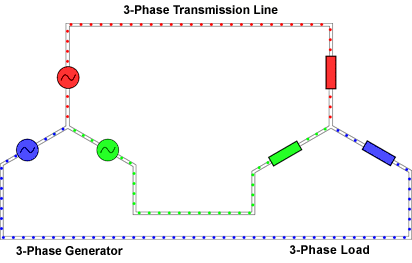
为什么使用三相?
- 发电机使用三相;三相是能够不使用辅助设备而产生“方向确定,有启动力矩”的旋转磁场的最少相数。
- 三相系统使用 4 根线可传输 3 倍的单相电能;三相变压器比单相变压器经济。
- 三相平衡时,中线中没有电流通过。
- 更多相系统的不平衡问题更复杂。
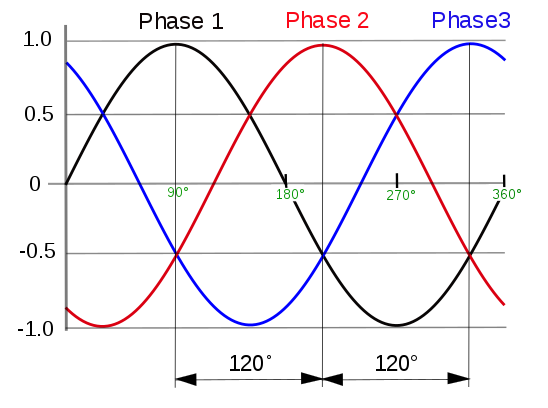
$$
\begin{aligned}
\dot{U}_\mathrm{A} &= U \angle 0^\circ \\
\dot{U}_\mathrm{B} &= U \angle -120^\circ \\
\dot{U}_\mathrm{C} &= U \angle 120^\circ
\end{aligned}
$$
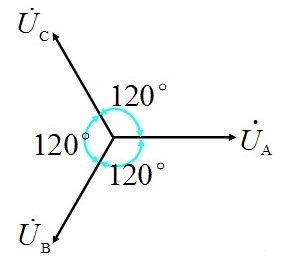
3.4.2 接线 / Configurations
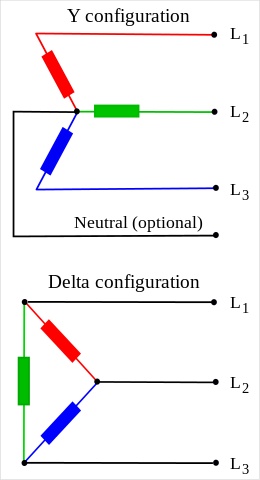
星形(Y,wye,star):$I_l = I_p,\ U_l = \sqrt{3}\ U_p$
三角形(Δ,delta):$U_l = U_p,\ I_l = \sqrt{3}\ I_p$
导线颜色(colour codes):
| 地线(PE) | 中线(N) | A 相 | B 相 | C 相 |
3.4.3 物理量 / Physical quantities
常用量:相电流 $I_p$ 和线电压 $U_l$
三相设备的额定容量(rated capacity)(视在功率,有时为有功功率):
$$
S = 3 S_p = 3 \frac{UI}{\sqrt{3}} = \sqrt{3} UI
$$
3.5 对称分量 / Symmetrical components
正序(direct,position)分量,负序(inverse,negative)分量,零序(zero,homopolar)分量
$$
\begin{aligned}
\overset{\cdot}{U}_\mathrm{A} &= \overset{\cdot}{U}_\mathrm{A}^{+} + \overset{\cdot}{U}_\mathrm{A}^{-} + \overset{\cdot}{U}_\mathrm{A}^{0} \\
\overset{\cdot}{U}_\mathrm{B} &= \overset{\cdot}{U}_\mathrm{B}^{+} + \overset{\cdot}{U}_\mathrm{B}^{-} + \overset{\cdot}{U}_\mathrm{B}^{0} = \alpha^2 \overset{\cdot}{U}_\mathrm{A}^{+} + \alpha \overset{\cdot}{U}_\mathrm{A}^{-} + \overset{\cdot}{U}_\mathrm{A}^{0} \\
\overset{\cdot}{U}_\mathrm{C} &= \overset{\cdot}{U}_\mathrm{C}^{+} + \overset{\cdot}{U}_\mathrm{C}^{-} + \overset{\cdot}{U}_\mathrm{C}^{0} = \alpha \overset{\cdot}{U}_\mathrm{A}^{+} + \alpha^2 \overset{\cdot}{U}_\mathrm{A}^{-} + \overset{\cdot}{U}_\mathrm{A}^{0}
\end{aligned}
$$
$$
\begin{aligned}
\overset{\cdot}{U}_\mathrm{A}^{+} &= \frac{1}{3} ( \overset{\cdot}{U}_\mathrm{A} + \alpha \overset{\cdot}{U}_\mathrm{B} + \alpha^2 \overset{\cdot}{U}_\mathrm{C} ) \\
\overset{\cdot}{U}_\mathrm{A}^{-} &= \frac{1}{3} ( \overset{\cdot}{U}_\mathrm{A} + \alpha^2 \overset{\cdot}{U}_\mathrm{B} + \alpha \overset{\cdot}{U}_\mathrm{C} ) \\
\overset{\cdot}{U}_\mathrm{A}^{0} &= \frac{1}{3} ( \overset{\cdot}{U}_\mathrm{A} + \overset{\cdot}{U}_\mathrm{B} + \overset{\cdot}{U}_\mathrm{C} )
\end{aligned}
$$
其中,$\alpha = \angle 120^\circ = e^{\mathrm{j} 120^\circ}$,$\alpha^2 = \angle 240^\circ = e^{\mathrm{j} 240^\circ}$。
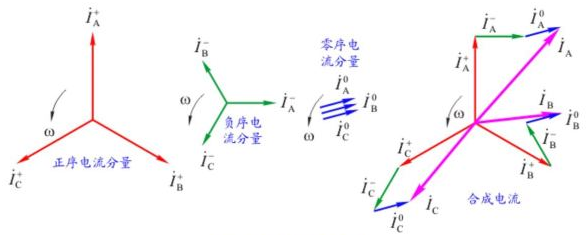
Leave a Reply